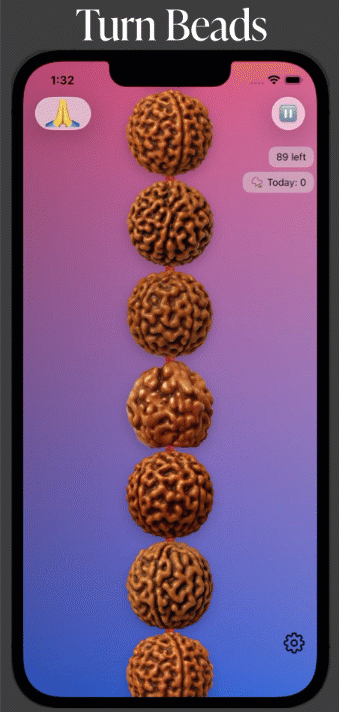Turn Beads
The iOS app for your spiritual practices 👌
The iOS app for your spiritual practices 👌
Turning The Beads
The Fastest Way To Go
From A Racing Mind >>>
To A Quiet Mind
The iOS app for your spiritual practices:
Japa Mala
Rosary
Affirmations
Misbaḥa
Sibha
Subha
Tesbih
Dhikr beads
Chotki
Coming soon to the App Store
© 2025 - Stop The Mind Meditation
• Use it to focus your attention with your own silent prayer or as you repeat your mantra, or use it with one of the included recordings of mantras, prayers and affirmations.
• Swipe up or down at your own pace - or turn on AutoPlay and set the tempo.
• Record your own mantra, prayer or any quote you wish to imbibe more deeply (pro feature).
• Create your personal library: morning prayers, afternoon mantras, evening affirmations - anything you like (premium).
• Import any sound file (premium feature) - bring the sound of your most inspiring mentors into your own practice.
• Select any number of beads per round: 11, 33, 50, 59, 99, 100, 108 - or set your own custom number
• Automatically keeps track of how many rounds you do each day.
• Select from different bead materials :
Rudraksha, rainbow, coral, pearl, jade, wood, and many more
Premium version even offers the ability to commission your own bead material.
.
• Control the background colors and music, and many more special features for a wonderful experience.
Turning The Beads
The Fastest Way To Go
From A Racing Mind >>> To A Quiet Mind
Prayer Beads have been used throughout time to help the mind stay focused on the prayer, without wandering. They are a wonderful magnet for our intention, bringing our attention into a sharp focus. Many, many faiths and traditions around the world use prayer beads in this way.
For instance, Buddhists and Hindus know the beads as a 'mala', and the act of meditative repetition of a mantra is called 'japa'. Malas traditionally have 108 beads plus a distinct center bead, known as the guru bead. The center bead is not counted; you return to it after each round.
Traditional mantras and prayers include ‘Om Namah Shivaya’, ‘Om Ram Ramaya Namaha’, ‘Om Mani Padme Hum’, ‘Hare Krishna’, ‘Allahu Akbar’, ‘Lord Jesus Christ Son of God have mercy on me’, ‘Wahegur'u’ — and so many other beautiful prayers to the Divine.
Rudraksha beads are often used in India for japa because these beads often have five faces or facets to them. They are associated with the five aspects of Shiva: creation, maintenance, dissolution, concealment and grace.
Muslim prayer beads are called misbaha (or misbaḥa/sibha/subha/tesbih/tasbih/dhikr beads) and are used for reciting praises of Allah (dhikr), with the number of beads often being 99, 33, or 11 to count the repetitions of these phrases. This app allows you to set the round of beads you are using to these sacred numbers as well. (Use the Pro feature allowing you to record your own voice to have your prayer be recited for you as you turn the beads.
Eastern Orthodoxy uses a prayer rope known as a 'chotki', used to combat temptations and achieve unceasing prayer, symbolizing unity with God and serving as a method to fulfill spiritual practices. Common counts are 33, 50 or 100.
The prayer beads are more than a counting tool; they are a map of inner unfolding
The Fourfold Rhythm of the Prayer Beads
When you move through your prayer beads, you’re not just counting beads — you’re tracing a complete cycle of consciousness. In many traditions, the circle is quietly divided into four quarters, each one marking a phase in the journey of awareness.
The first quarter begins with the first bead after the guru bead, or Central Bead — the moment of intention. It’s the setting out, the awakening of resolve, the conscious choice to turn inward.
The second quarter carries the movement of expansion. The mantra or prayer gathers rhythm and life; attention stabilizes; the surface of the mind begins to settle.
The third quarter deepens into fulfillment. The repetition becomes effortless, the prayer or mantra almost thinks itself, and the boundaries between sound and silence begin to blur.
The final quarter dissolves into rest. The words becomes a whisper, or stops altogether, and what remains is the stillness it revealed. The circle closes back upon itself, and the next turn begins.
In the same way, the app itself reflects this quiet symmetry: the mind’s intention above, the grounding of sound below, the movement of beads through the center, and the subtle field of color and light surrounding it all.
Every cycle, every quarter, every breath — the same wholeness expressed again and again.
